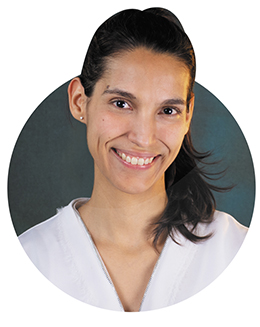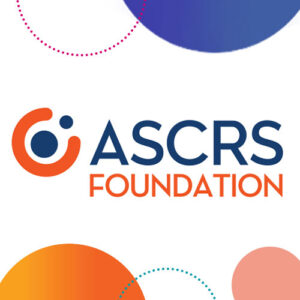ASCRS News: ASCRS/EyeWorld Journal Club
April 2022
by Andrea C. Arteaga, MD, Maria Soledad Cortina, MD, Peter MacIntosh, MD

Residency Program Director
Illinois Eye and Ear Infirmary
Chicago, Illinois
Modern cataract surgery requires the surgeon to deliver not only visual improvement but also excellent refractive outcomes. Spectacle independence has become part of the goal after surgery for many patients. The correction of visually significant astigmatism is therefore extremely important to achieve desired outcomes. It’s been reported that 50% of patients have significant corneal astigmatism and up to 10% have more than 2 D.1,2 Even 0.5 to 0.75 D can cause undesirable outcomes and subjective visual symptoms that can worsen the visual quality, particularly in patients undergoing multifocal lens implantation.
There are multiple options available to reduce astigmatism during cataract surgery. Toric intraocular lenses are highly effective in treating astigmatism. Limbal relaxing incisions (LRI) have been shown to reduce mild to moderate astigmatism with good long-term outcomes. Manual LRIs are a safe option, although under correction is the norm in most cases.

Co-Director of the Cornea Service
Illinois Eye and Ear Infirmary
Chicago, Illinois
During training, residents must learn conventional cataract surgery but should also in time become familiar with astigmatic correction techniques. Most residency programs will have toric intraocular lenses as the main option for astigmatic correction. According to an ASCRS survey, 50% of senior residents had not done LRIs before graduation and 70% thought that they had inadequate experience after graduation.3
To address this resident sentiment, the authors designed a surgical curriculum to introduce in a stepwise approach astigmatic keratotomies (AK) to residents.
Methods
This was a retrospective study of patients who underwent cataract surgery performed by senior residents as primary surgeons from three classes. Patients included had visually significant cataract, astigmatism less than 2.5 D, non-perforated LRI, and at least 1 year of follow-up.

Resident
Illinois Eye and Ear Infirmary
Chicago, Illinois
The surgical curriculum consisted of three different phases, each one with unique objectives, teaching methods, and assessment methods. The first phase included didactics covering fundamentals of LRIs such as patient selection, calculations, and practice in the wet lab with direct feedback and evaluations. In the second phase, residents would calculate the LRI and assist and observe while the attending physician performed the surgery. In the third phase, the resident would complete every step of the surgery from preoperative calculation to performing the LRI. Every step would be supervised and objectively graded by an attending physician using the Extracapsular Cataract Extraction International Council of Ophthalmology (ICO) Ophthalmology Surgical Competency Assessment Rubric (ICO-OSCAR) form.
Results and discussion
A total of 118 eyes were included in the final analysis. Mean preoperative corneal astigmatism was 1.36 D. At postoperative month 1 (POM1), 90% of the eyes achieved best corrected visual acuity (BCVA) of 20/25 or better and 77% for postoperative month 12 (POM12). Regarding astigmatism, 34% and 36% of eyes achieved a refractive cylinder of 0.5 D or less at POM1 and POM12, respectively. Patients were divided into groups for the analysis depending on the steep meridian location (with-the-rule, against-the-rule, or oblique astigmatism) and depending on the magnitude of the astigmatism (<1 D, 1–2 D, and >2 D). All groups demonstrated a statistically significant reduction of the keratometric astigmatism postoperatively that was sustained during the follow-up time.
Under correction of astigmatism was seen in all patients. This is most likely due to healing and remodeling of the cornea that mainly occurs 10 weeks postoperatively. The highest change was seen at the POM1 timepoint, but there was not much difference at POM3 and POM12, indicating that the majority of the corneal healing occurs before the first 3 months postoperatively. After the third month changes are minimal.
The ASCRS Journal Club highlighted the importance of having multiple options to improve astigmatism and refractive outcomes after cataract surgery. LRIs are a safe and cost-effective option to correct low-grade astigmatism. Also, it was discussed how to introduce this skill during residency. All agreed in the importance of wet lab time to practice and master the surgical technique.
According to an ASCRS survey, 50% of senior residents had not done LRIs before graduation and 70% thought that they had inadequate experience after graduation.
Conclusion
The results of the study showed that resident-performed LRIs are safe and effective regardless of the magnitude or location of the astigmatism and were stable over time. The surgical curriculum model described is an objective and useful option to introduce LRIs to the surgical curriculum of residency programs.
Refractive and keratometric outcomes of supervised novice surgeon-performed limbal relaxing incisions: 1-year results
Kamran Riaz, MD, Li Wang, MD, PhD, Blake Williams, MD, Justin Dvorak, PhD, Carolyn Kloek, MD, Asim Farooq, MD, Douglas Koch, MD
J Cataract Refract Surg. 2021;47(10):1319–1326
- Purpose: To report refractive and keratometric astigmatism outcomes of resident-performed limbal relaxing incisions (LRIs) during cataract surgery.
- Setting: Tertiary care academic teaching hospital.
- Design: Retrospective case series.
- Methods: The length, location, and number of LRIs were determined preoperatively using an online calculator. Variables studied were preoperative keratometry and postoperative uncorrected and best-corrected distance visual acuity, refraction, and keratometry at 1-month, 3-month, and 12-month visits (POM1, POM3, and POM12, respectively). Subgroup analysis was performed on amount and type of astigmatism. The astigmatism double-angle plot tool and analysis of with-the-wound and against-the-wound (WTW-ATW) changes were used to assess the effect of astigmatism correction at POM1, POM3, and POM12 visits.
- Results: In 118 eyes, a higher percentage of eyes demonstrated refractive astigmatism ≤0.25 D, ≤0.50 D, ≤0.75 D, and ≤1.0 D at POM1 and POM12 (all P<0.05) compared to preoperative keratometric astigmatism. Subgroup analysis showed improvement in all groups and types of astigmatism (p<0.01). Patients achieved a statistically significant reduction of keratometric astigmatism at POM1, POM3, and POM12 (all p≤0.0001) relative to baseline, and changes differed significantly based on the preoperative amount of astigmatism (all p≤0.0001, with greater reductions associated with higher baseline astigmatism), but not by location of the steep meridian. There were significant WTW-ATW changes at POM1, POM3, and POM12. Regression of effect after 1 month was approximately 0.11 D.
- Conclusion: Resident-performed LRIs achieved effective and sustained reduction of both refractive and keratometric astigmatism regardless of meridian or magnitude of astigmatism for at least 1 year after surgery.
References
- Budak K, et al. Limbal relaxing incisions with cataract surgery. J Cataract Refract Surg. 1998;24:503–508.
- Khan MI, Muhtaseb M. Prevalence of corneal astigmatism in patients having routine cataract surgery at a teaching hospital in the United Kingdom. J Cataract Refract Surg. 2011;37:1751–1755.
- Yeu E, et al. Resident surgical experience with lens and corneal refractive surgery: survey of the ASCRS Young Physicians and Residents membership. J Cataract Refract Surg. 2013;39:279–284.
Contact
Arteaga: aartea7@uic.edu
MacIntosh: pmacint1@uic.edu



